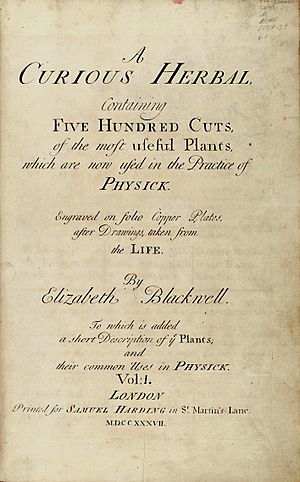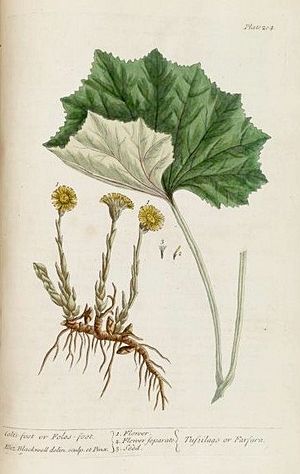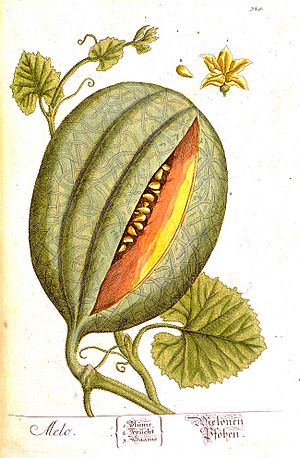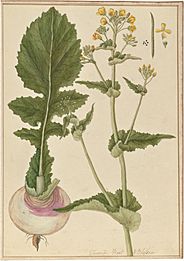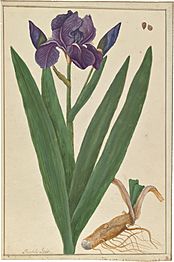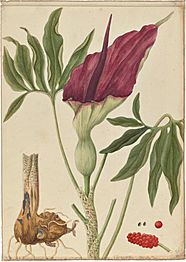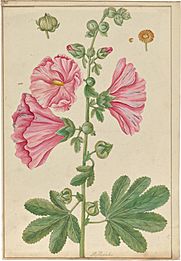Elizabeth Blackwell (illustrator) facts for kids
Quick facts for kids
Elizabeth Blackwell
|
|
|---|---|
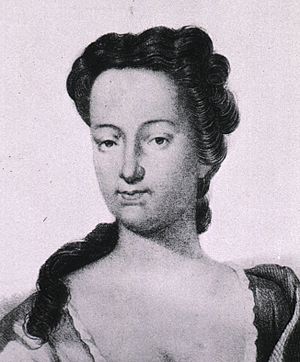 |
|
| Born | 1707 |
| Died | 1758 |
| Nationality | Scottish |
| Known for | illustrator |
| Spouse(s) | Alexander Blackwell |
Elizabeth Blackwell (1707 –1758) was a talented Scottish botanical illustrator and author. She is most famous for drawing and engraving all the pictures for her book, "A Curious Herbal". This amazing book was published between 1737 and 1739. It showed many different medicinal plants and was a very helpful guide for doctors and pharmacists at the time.
Contents
Elizabeth Blackwell's Story
Early Life in Aberdeen
Elizabeth Blachrie grew up in Aberdeen, Scotland. Her father was a successful merchant, and she learned how to be an artist.
She secretly married her cousin, Alexander Blackwell. He was a doctor and economist. They lived in Aberdeen, where he worked as a doctor. However, some people questioned if he was truly qualified. Because of this, the young couple quickly moved to London. They were worried Alexander might be accused of practicing medicine illegally.
Moving to London
In London, Alexander started working with a publishing company. After gaining some experience, he decided to open his own printing business. But he didn't belong to the right trade groups and hadn't completed the necessary training. He was accused of breaking the strict rules for printers. He had to pay a large fine, which forced him to close his shop.
A Difficult Time
By this time, Elizabeth and Alexander were in serious financial trouble. Because of Alexander's expensive habits and the fines, they owed a lot of money. Alexander was even sent to prison because of these debts.
With her husband in prison, Elizabeth faced a very difficult situation. She had a home to manage and a child to care for, but no income. She learned that there was a need for a new book about plants, especially exotic ones from the New World. She decided that she could draw the plants, and Alexander, with his medical background, could write the descriptions.
As she finished each drawing, Elizabeth would take it to her husband's prison cell. There, Alexander would add the correct names for the plants in many languages, including Latin, Greek, Italian, Spanish, Dutch, and German.
Elizabeth was not an expert in botany (the study of plants). To help her, Isaac Rand, who was in charge of the Chelsea Physic Garden, offered his assistance. Many of the new plants Elizabeth needed to draw were growing in this garden. At Rand's suggestion, she moved closer to the garden so she could draw the plants while they were fresh.
Besides drawing, Elizabeth also engraved the copper plates used for printing the 500 images and text. She then carefully hand-colored each printed illustration herself.
Success of A Curious Herbal
The first printing of A Curious Herbal was quite successful. This was because of the detailed and beautiful illustrations, and also because there was a great need for an updated plant guide. Doctors and pharmacists praised her work. The Royal College of Physicians even gave it a special commendation.
About 20 years later, a second edition of the book was printed in Nuremberg, Germany. It was revised and made larger by a botanist and doctor named Dr. Trew, and was published between 1757 and 1773.
The money earned from the book helped Alexander get out of prison. However, soon after, they again faced money problems. This forced them to sell some of the rights to the book. Alexander also tried several business ideas that didn't work out. Eventually, he left his family to start a new life in Sweden.
Alexander's Life in Sweden
Alexander Blackwell arrived in Sweden in 1742. He continued with farming experiments he had started earlier, such as breeding horses and sheep, and managing dairy farms. His achievements were recognized, and he was appointed as a doctor to Frederick I of Sweden, the king.
Alexander tried to improve the connections between Great Britain, Denmark, and Sweden. Since Great Britain didn't have an ambassador in Sweden, he contacted a minister in Denmark. Based on some evidence, he was accused of plotting against the Crown Prince. He was put on trial and sentenced to death. On August 9, 1747, he was executed, just as his wife Elizabeth was leaving London to join him.
Elizabeth's Later Years
Not much is known about Elizabeth Blackwell's life after Alexander's death. She was buried on October 27, 1758, at Chelsea Old Church in Chelsea, London. She remained loyal to Alexander throughout her life, even sharing the money she earned from selling more rights to her book with him.
A group of plants, called Blackwellia, was named after her. These plants belong to the Dodecandria Pentagynia class. There are six types of Blackwellia plants: Blackwellia Panticulata, Blackwellia Glauca, Blackwellia Nipaulensis, Blackwellia Axillaris, Blackwellia Siralis, and Blackwellia Padifolia. These plants are found in places like Réunion, Mauritius, Nepal, Madagascar, Peru, and China.
Featured at the British Library
Elizabeth Blackwell's book, "A Curious Herbal", has been featured on the British Library website. It is called a "classic of botanical illustration." You can even view the book online using their Turning the Pages system.
Gallery
See also
 In Spanish: Elizabeth Blackwell (ilustradora) para niños
In Spanish: Elizabeth Blackwell (ilustradora) para niños


